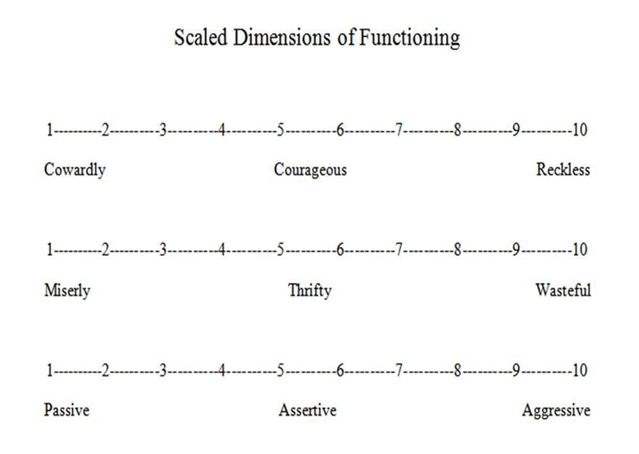Cognition
Finding Goldilocks: A Solution for Black-and-White Thinking
The sweet spot between opposite extremes is the zone of effective living.
Posted May 1, 2020 Reviewed by Matt Huston
The Goldilocks Principle got its name from a children’s story in which the protagonist noticed that qualities lying midway between two opposite extremes (e.g., hot and cold, hard and soft) are pleasant, satisfying, and “just right.” Wikipedia describes applications of this versatile principle in developmental psychology, economics, communication science, medicine, and astrobiology. This blog will apply the Goldilocks Principle to personal development, relationships, and politics.
In ancient times, several philosophers and religious leaders, living in separate cultures and with no knowledge of each other, developed the idea that optimal human functioning usually consists of a moderate balance between opposite extremes (Shapiro, 2015a). In ancient Greece, Aristotle coined the term Golden Mean to summarize this idea; in India, Buddha used the term Middle Way; and in China, Confucius espoused his Doctrine of the Mean. These are different words for the same idea: Skillful, effective functioning is generally moderate and balanced, and maladaptive behavior typically involves extremes, including opposite extremes. Goldilocks would have gotten along well with both ancient philosophers and modern scientists.
Moderation versus Polarization
The concept of adaptive moderation has been prominent in the psychotherapy field for some time. This concept is especially relevant to people whose difficulties are due to black-and-white thinking, because this type of cognition is incompatible with moderation. Black-and-white or dichotomous thinking is a hallmark of Borderline Personality Disorder, and it also appears in a wide range of other disturbances. This type of thinking is featured prominently in well-known lists of cognitive distortions by Beck (2011) and Burns (1999).
The difference between people with diagnosable disturbances and those with ordinary problems in living is generally just a matter of degree, and the same is true for black-and-white thinking. Everyone does it sometimes, and some do it so much, or in regard to such important issues, that a serious disturbance results. Dichotomous thinking is often involved in significant problems in living and conflicts in relationships. Also, black-and-white thinking seems to contribute mightily to the acrimonious, divisive nature of politics in the United States (and other countries) at the present time.
Dichotomous thinking is typically polarized—complex realities are simplified into two opposite extremes or poles of a spectrum. For example, an individual might categorize all possible responses to conflict as either submissive or aggressive because she is unaware of assertive behavior as a distinct option that lies in between.
In polarized thinking, people typically seize on one pole of a spectrum as purely good and reject the other pole as purely bad, and they become fixated on one extreme point of view to the exclusion of all other perspectives. Schneider and Fatemi (2019), an American psychologist and an Iranian psychologist who work together on the problem of intergroup hostility, identified polarized thinking as the biggest single threat to peace between nations and cultures.
The words “dichotomous” and “polarized” are not literally synonyms, but psychological discussions often use the words interchangeably, because the two types of cognitive distortion typically occur together. This association is captured by the term “black and white,” which refers both to a dichotomy and to a pair of opposite extremes without gradations in between.
The Problem With Black-and-White Thinking
Dichotomous, polarized thinking is maladaptive for several reasons. This type of cognition results in a distorted picture of any reality that is not, in fact, dichotomous—and human realities rarely are. Black-and-white thinking results in oversimplified understandings of both other people and the self.
This cognitive style prevents people from being aware of the full range of possibilities available to them. People feel they must make either/or choices when there are actually many options in between.
For example, when thinking is dichotomous, people may categorize their relationship partners as either wonderful or awful, adoring or rejecting, devoted or indifferent, with nothing in between. When the partner does something the individual views as outside the good category, he re-categorizes her in the bad half of the dichotomy, and his emotional reactions flow from there (e.g., “If she really loved me, she would never have said that”).
Perfectionism is another cognitive distortion that, in essence, boils down to black-and-white thinking. In realms such as work and school, perfectionists recognize just two levels of performance: perfection and failure. As a result, any flaw in their work, no matter how minor, is viewed as excluding their performance from the good category and placing it in the bad one. As another example, people with eating disorders often recognize just two types of bodies: perfect and ugly (or fat). As a result, any flaw in their bodies, no matter how minor, is viewed as excluding their physical self from the good category and placing it in the bad one.
As these examples illustrate, it is practically impossible to live comfortably with a black-and-white picture of a world containing many shades of gray. There has to be a better way, and there is.
Finding the Middle Way
Aristotle taught that moderation is the key to virtue. In his Nicomachean Ethics, he analyzed virtue and vice by identifying quantitative relationships between words used to describe opposite extremes and midpoints on dimensions of human functioning. For instance, he conceptualized courage as the adaptive midpoint between the maladaptive extremes of cowardice and recklessness. Aristotle reasoned thusly: It is bad to be a coward, dominated by fear, and it is also bad to be reckless, oblivious to fear; the virtuous way in the middle is courage, which combines elements from both ends of this spectrum in a synthesis.
Jumping ahead 2,500 years, there are many examples of the Aristotelian analysis in modern psychology. For instance, it is bad to be aggressive and violent, rolling over people as if their needs don’t count, and it is bad to be passive and submissive, allowing people to roll over us as if our needs don’t count; the virtuous way in the middle is assertiveness, the adaptive midpoint between these two extremes (Feindler and Ecton, 1994). As another example, miserliness is a dysfunctional attribute, and so is its opposite, wasteful extravagance, while the quality lying in between, thrift, is adaptive (Shapiro, 2015b). One of the central strategies of Dialectical Behavior Therapy (Linehan, 2014) is to help clients integrate opposite forms of value and personal attributes into adaptive syntheses.
10-Point Scales as Tools for Effective Thinking
Opposite extremes and moderate middles can be represented with numbers and words on scales that describe dimensions of emotion, thought, behavior, and personality. When written on paper or computer screens, these scales provide a visual tool that supplements verbal reasoning with spatial information.
Numbered scales can help us conceptualize personal issues and move from black-and-white thinking to more nuanced, balanced forms of cognition. These more sophisticated cognitive structures can then be used to develop moderate, flexible emotions and behaviors in the life areas that have been giving us trouble.
On this blog, we are going to make extensive use of the familiar schema of the 10-point scale. Although it is a simple tool, it is remarkably versatile and can be applied to all sorts of human issues, dilemmas, and problems, from the personal (micro) to the political (macro). For example, here are diagrams of the three personality-related dimensions mentioned so far:

As you can see from these examples, when styles of functioning are conceptualized on continuums, both sides involve advantages, both involve disadvantages, and optimally adaptive combinations are located in the middle—the Goldilocks Zone (Shapiro, 2020). For example, passive behavior has the advantage of respecting other people's rights and the disadvantage of neglecting our own, aggressive behavior has the exact opposite set of attributes, and assertiveness involves a balanced respect for both other people and the self.
Many mental health problems can be conceptualized as points close to the poles of spectrums like these, and optimally effective styles are usually in the mid ranges. Aristotle was a good psychologist.
Ten-point scales have important capabilities as conceptual tools. Their two-sided structure prompts us to consider the elements of truth and value on both ends of the spectrum and to see how they can be brought together in optimal combinations. Used in this way, 10-point scales are visual templates for dialectical thinking; they guide a thought process that moves from opposing polarities to balanced syntheses.
Both the physical structure of the scales and the numbers used to calibrate them prompt us to think in careful, measured ways, rather than in big, undifferentiated chunks of meaning. The idea is not to be picky about numbers but to approach two-sided issues as matters of degree and balance.
While this gray style of thinking is more labor-intensive and less cathartic than glomming onto one side of a two-sided issue and lunging for a simple solution, it is far more accurate and constructive. Used effectively, scales like these provide an antidote for black-and-white thinking.
In blog posts to come, we will apply this conceptual tool to a wide variety of purposes and content areas, including:
- Self-assessment
- Understanding other people
- Personal goal setting
- Mental health problems such as anxiety, aggression, perfectionism, and oppositionality
- Moral dilemmas
- Problems in romantic and marital relationships
- Parent-child problems
- Politics
In the meantime, you might try out this analytical technique on the human problems, dilemmas, and conflicts of interest to you. I think you will find that you can conceptualize all sorts of issues by constructing 10-point scales with poles corresponding to two opposite extremes and adaptive syntheses in the middle. I will provide many examples of these analyses in posts to come.
References
Beck, J. S. (2011). Cognitive behavior therapy: Basics and beyond (2nd ed.). New York: Guilford.
Burns, D. D. (1999). Feeling good: The new mood therapy revised and updated. New York: Avon.
Feindler, E. L., & Ecton, R. B. (1994). Adolescent anger control: Cognitive-behavioral techniques. Needham Heights, MA: Allyn & Bacon.
Linehan, M. M. (2014). DBT skills training manual (2nd ed.). New York: Guilford.
Schneider, K. J., & Fatemi, S. M. (2019, April 16). Today’s biggest threat: The polarized mind. Scientific American.
Shapiro, J. P. (2015a). Child and adolescent therapy: Science and art (2nd ed.). New York: Wiley.
Shapiro, J. P. (2015b). How to get more happiness from less stuff: Make the psychology of money work for you. Amazon Digital Services.
Shapiro, J. (2020). Finding Goldilocks: A guide for creating balance in personal change, relationships, and politics. Amazon Digital Services.




